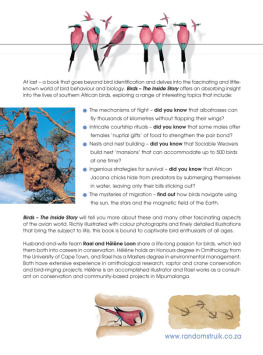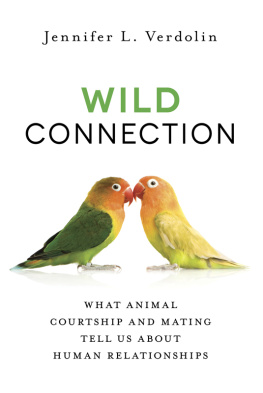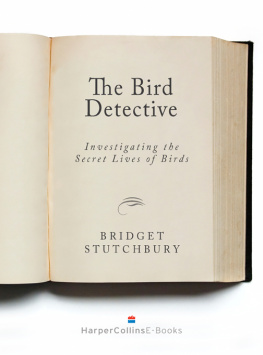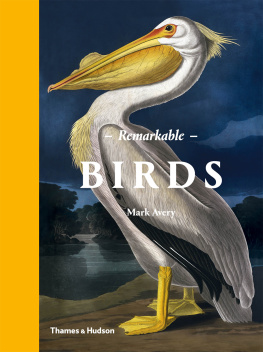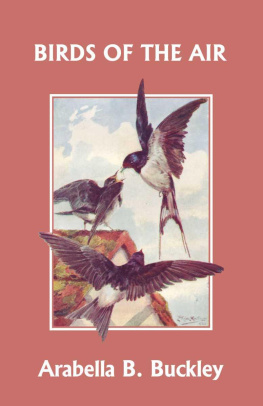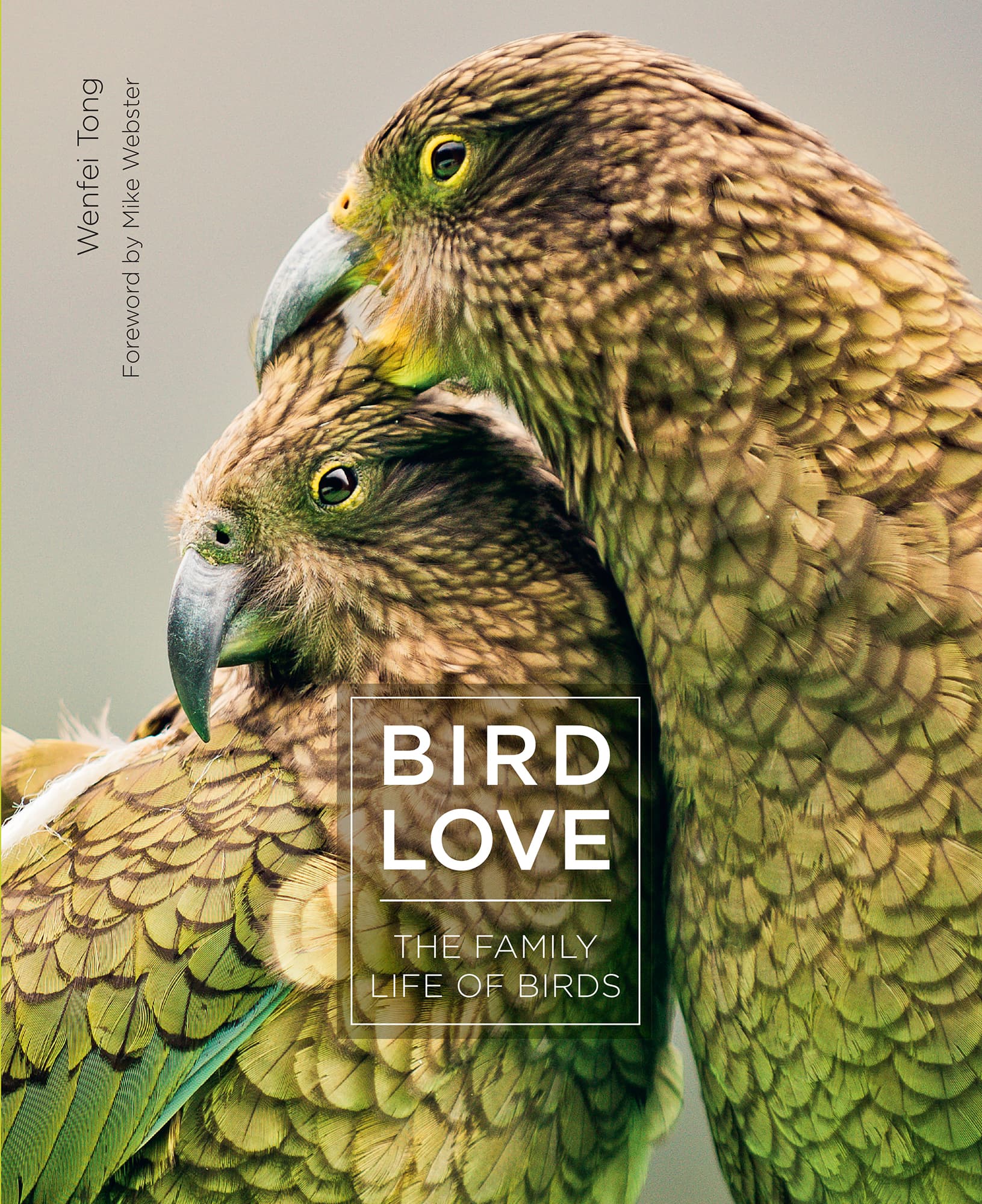BIRD LOVE
THE FAMILY LIFE OF BIRDS
Wenfei Tong
Consultant Editor Mike Webster

FOREWORD
By Mike Webster
A pair of barn swallows has built a nest under the roof over my front porch. In fact, this same pair has nested on my porch for the past few years, returning each spring to build their cup-like mud nest in the exact same spot. This has given my wife and me an excellent front-row seat to the family life of these little birds. We see the male excitedly court and sing to his mate, wooing and gently coaxing her to start nesting. We watch them build up a nest from nothing, bit by bit with small bill-fulls of mud, then line it with feathers, eventually laying four brown eggs and then feeding the noisy, begging nestlings that emerge from those eggs. And after the young fledge and take to the wing themselves, albeit awkwardly at first, we watch the parents start all over again to squeeze in a second brood before the fall comes and they make the return journey to their southern wintering grounds.
Our swallows are the very picture of a cooperative, monogamous, and loving family. Yet, as a behavioral biologist, I know that lying beneath that cooperation is a lot of complexity, competition, and conflict. The male courts his mate with song and showy plumage, but he also courts and copulates with the mates of other males, and his own mate will likely copulate with extra-pair males herself. He will jealously guard her and repel rival males to keep that from happening, and possibly will reduce his own parental care if he suspects that some of the young in his nest are not his own. The young in the nest also compete with each other, each selfishly trying to extract as much parental care as possible. And the parents will conflict with those offspring on who gets the food, and also when to leave home.
That is all in just one species. Across the 10,000-plus species of bird that live on this planet, there is an amazing diversity of behaviors aimed at one simple goal: reproduction. This book is a collection of some amazing examples of these, from elaborate courtship displays that give potential mates information about genetic quality, to intricate nests designed to protect the young from predators and parasites. We see loving parents, including same-sex partners that raise their young together, and individuals that forgo breeding altogether to help others instead. But we also see the dark side of reproduction: aggression, sneaky matings, deceit, infanticide, and parents that dupe others into raising their young. This book is about that behavioral diversity, and about the many ways that birds have evolved to pass their genes onto the next generation. I hope you enjoy reading it as much as I have.
INTRODUCTION
Bird family life can look rosy, from the long-term pair-bonds of parrots and albatrosses to the many species in which both sexes, and sometimes an extended family, share parental care duties. However, nature is amoral and a darker side, including sexual conflict, infanticide, and siblicide, is equally common. This book examines how and why both the light and dark sides of bird family life have evolved.
Bird reproductive strategies, from finding a mate to raising offspring, have evolved under a wide range of selective forces, producing diverse behaviors, from using cosmetics to kidnapping nannies. Birds are everywhere, and this book aims to deepen your appreciation of the birds you see every day, wherever you live, and also any new birds you encounter. It celebrates the global diversity of avian reproductive strategies, from the almost universal infidelity among socially bonded birds to the benefits of long-term partnerships; from single-parent families to clans that rear the next generation cooperatively.
Monogamy is the best reproductive strategy for Atlantic puffins.
This book is peppered with analogies and the language of agency as shorthand for describing the long-term evolutionary benefits underlying bird behavior. Saying something like birds will evolve to bring more food to chicks in response to louder hunger cries if the genetic variation for that behavioral rule is passed on to a larger proportion of the next generation is rather a mouthful. To avoid giving you indigestion, I resort to giving birds agency. For instance, birds behaving almost like conscious investors of their genes in economic analogies are a recurring theme in this book.
The trouble with being a sexually reproducing organism is that one has to go to the effort of finding a partner with whom to invest in the next generation. An alternative, but not mutually exclusive, route is to perpetuate ones genes by helping relatives reproduce. Many organisms, including some humans, do this. However, regardless of whether the inherently cooperative venture of reproduction occurs in pairs or groups, it is always subject to conflicts of interest because none of the members genetic interests are completely aligned. For instance, a male bird may have less of a genetic stake in a brood of chicks than his mate, because she has mated with multiple males.
Although both parents have equal genetic shares in each chick, they seldom invest equally in resources that improve their chicks chances of surviving to reproduce. We will explore how the asymmetry in male and female investment in sex cells also explains many other sex differences.
Male and female Java sparrows look very similar, but only the male sings.
INVESTMENT ASYMMETRIES
Why are so many female birds a dowdy brown when their mates are covered in iridescent splendor, and why are single parents in the bird world usually female? The answers to both these questions come back to an early asymmetry in parental investment between females and males.
Biologists define the sexes not by how they look or behave, but by the size of their sex cells. Females make larger sex cells such as eggs, whereas males make smaller sex cells such as sperm. In some organismsincluding seed plants, mammals, or birdsthis early asymmetry in parental investment is further exaggerated, so that females invest even more in nutrient-rich seeds, placentas, or egg yolks.
Choosy females and flashy males
The female reproductive strategy, with large-investment eggs, is quality over quantity, whereas the male strategy is typically the reverse. In the same way as, if you wanted to invest a large amount of cash in only a few blue-chip stocks, you would choose those stocks with care, females tend to be the choosier sex because they make a few large investments in their eggs, and it pays to carefully choose a high-quality mate.
The opportunity costs of a bad investment are much higher for a females future reproduction than for a males, for sperm are individually cheaper than eggs. That is why in most bird mating markets, females are the buyers and males must advertise through song and dance.


